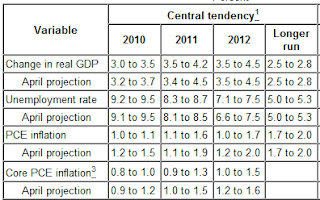Title should be "Economy Weakens as Bernanke says Fed Ready to Step in if Economy Weakens."
From the piece:
Mr. Bernanke said he saw "no support" on the committee for setting a higher inflation target, as some economists have suggested. He called the strategy "inappropriate for the United States in current circumstances."Goody gumdrops! And yet Bernanke saw much support on the committee for years of high unemployment. The Federal Reserve Bank of America - many of whose decision makers are appointed by private sector banks* - is losing legitimacy by the day.
Bernanke passes the buck to the do-nothing Senate, which has already lost its legitimacy:
Mr. Bernanke made clear that while the Fed could take various steps, including large purchases of government debt, "central bankers alone cannot solve the world’s economic problems." Speaking at the Fed’s annual symposium here, he hinted broadly that political leaders had to take steps to tackle the deficit and the trade imbalance.-----------------------------------
* Imagine the outcry, say, if half the decision makers on the National Labor Relations Boards were appointed by labor unions.






.svg.png)